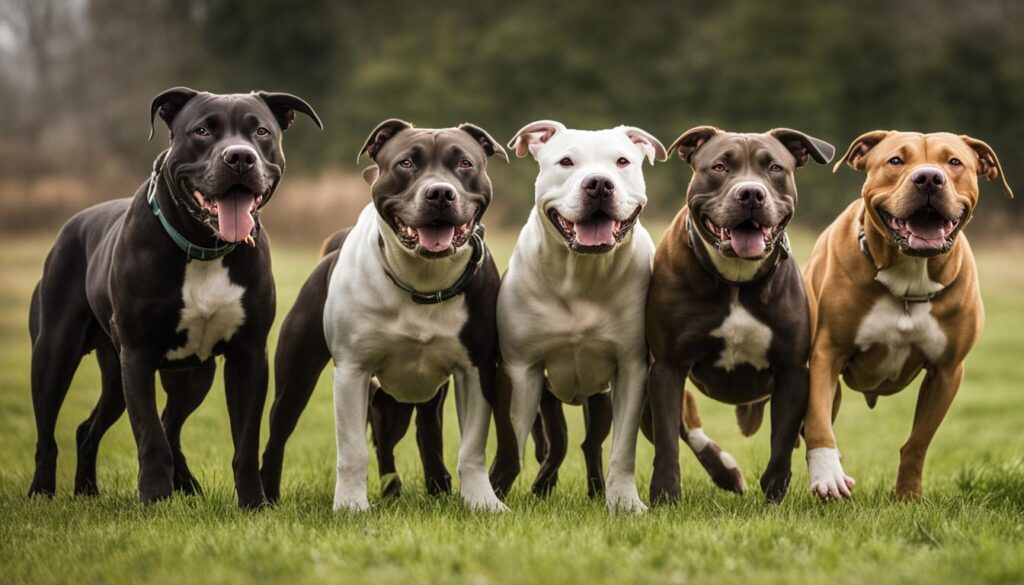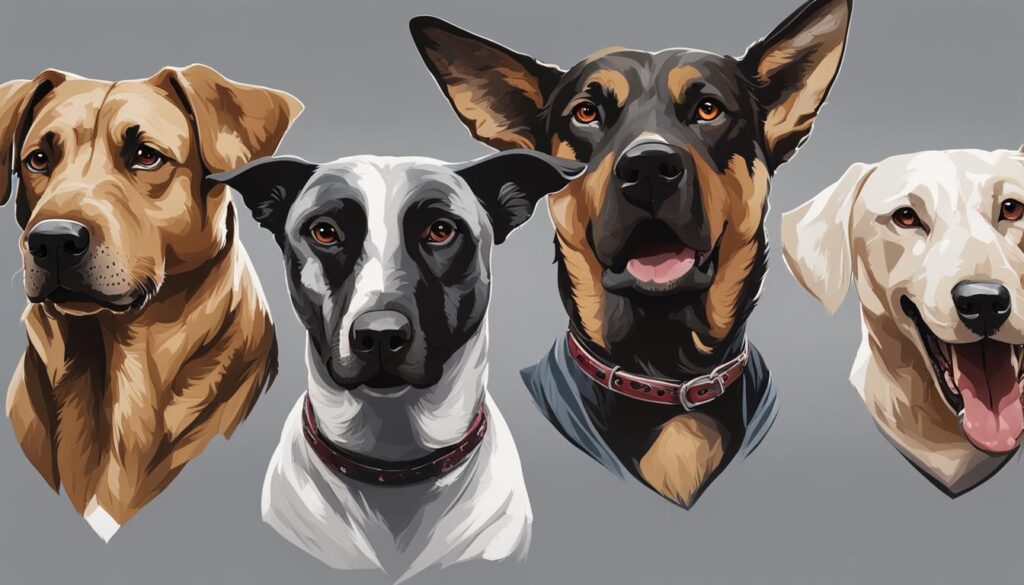As a professional journalist with a passion for debunking myths and providing accurate information, I am excited to delve into the topic of mean dog breeds. Throughout history, humans have created stories and stereotypes about certain breeds, labeling them as aggressive, tough, intimidating, dominant, strong-willed, challenging, or feisty. However, it is crucial to separate fact from fiction when it comes to understanding the behavior of these breeds.
Contrary to popular belief, the behavior of dogs is not solely determined by their breed. It is essential to remember that individual dogs have unique personalities and temperaments, which can be influenced by a variety of factors, such as their genetics, environment, training, and socialization. So, let’s explore the truth behind the myths surrounding mean dog breeds and gain a better understanding of their behavior.
Key Takeaways:
- Mean dog breeds are often misunderstood due to common myths and stereotypes.
- Dog behavior is influenced by various factors, including genetics, environment, training, and socialization.
- Individual dogs have unique personalities and should not be judged solely based on their breed.
- Responsible ownership, training, and socialization play vital roles in shaping a dog’s behavior.
- Educating ourselves about dog behavior helps promote positive relationships between dogs and humans.
Common Misconceptions About Small Dog Breeds

There is a common myth that small dog breeds are naturally aggressive. However, there is no scientific evidence to support this claim. The behavior of small dogs is more influenced by their owner’s behavior and lack of proper training. Small dog breeds require humane obedience training and early socialization to become well-adjusted adult dogs.
Contrary to popular belief, aggression is not a characteristic inherent to small dog breeds. The perception of aggression in small dogs may arise from their often vocal and confident nature, which can be misinterpreted as aggression. In reality, small dogs exhibit aggression as a result of factors such as fear, anxiety, or inadequate socialization and training.
To address behavioral issues and prevent aggression in small dogs, proper training techniques should be employed. Positive reinforcement training methods can be highly effective in teaching small dogs appropriate behavior while maintaining their happy and confident disposition. Consistency, patience, and reward-based training are key to shaping the behavior of small dogs.
Furthermore, early socialization plays a crucial role in shaping the temperament of small dogs. Exposing them to a variety of people, animals, and environments from an early age helps them develop positive associations and reduces the likelihood of fear-based aggression later in life. Socialization also helps small dogs build confidence and develop good manners in various social situations.
Training and socialization are essential for all dogs, regardless of their size or breed. However, small dogs, in particular, benefit greatly from positive reinforcement training and early socialization to prevent aggressive behavior and ensure they grow up to be well-mannered and friendly companions.
Training Small Dogs: Tips for Success
When training small dogs, it is important to consider their size and unique needs. Here are some tips to help you effectively train and socialize your small dog:
- Start early: Begin training and socializing your small dog as early as possible to establish positive behaviors and habits.
- Use positive reinforcement: Reward good behavior with treats, praise, and affection to motivate and encourage your small dog.
- Be consistent: Establish clear rules and expectations, and ensure everyone in the household follows them consistently.
- Keep it short and fun: Small dogs have shorter attention spans, so keep training sessions brief and engaging.
- Expose to new experiences: Introduce your small dog to a variety of people, animals, and environments to build confidence and prevent fear-based aggression.
- Seek professional help if needed: If you are facing challenges with training your small dog, consider consulting a professional dog trainer or behaviorist for guidance and support.
The Importance of Socialization for Small Dogs
Socialization is a critical aspect of raising a well-rounded and non-aggressive small dog. By exposing your small dog to different environments, people, and animals, you can help them develop the necessary social skills to interact positively with the world around them.
Proper socialization can prevent behavioral issues such as fear, anxiety, and aggression, which can be more common in small dogs that have not been adequately exposed to various stimuli. Socialization also contributes to the overall mental and emotional well-being of small dogs, promoting a happy and confident demeanor.
Remember, small dog breeds are not inherently aggressive. With the right training and socialization, small dogs can be loving, well-behaved, and enjoyable companions.
| Size | Examples |
|---|---|
| Toy Breeds | Chihuahua, Maltese, Yorkshire Terrier |
| Small Breeds | Cavalier King Charles Spaniel, Shih Tzu, Pomeranian |
| Mixed Breeds | Mixed-breed dogs that fall into the small category |
Table: Examples of Small Dog Breeds
Debunking the Myth: Large Dogs in Apartments

Many people believe that large dog breeds cannot live in apartments. However, the truth is that most dogs can adapt to living in small spaces as long as they receive enough exercise and mental stimulation. While high-energy breeds may require more activity, most dogs are content as long as they have regular opportunities to burn off excess energy.
Living with large dogs in apartments requires careful planning and consideration. Here are some key points to keep in mind:
- Exercise: Large dogs need regular exercise to maintain their physical and mental well-being. Provide them with daily walks, play sessions, and access to open spaces such as parks or dog-friendly areas.
- Enrichment: To keep your large dog stimulated, offer puzzle toys, interactive games, and training activities. Mental exercise is just as important as physical exercise for their overall happiness.
- Space management: While apartments may have limited space, you can optimize it by providing designated areas for your dog, such as a comfortable bed, food and water stations, and a dedicated spot for their toys.
- Training: Basic obedience training is essential for all dogs, regardless of size. Teach your large dog commands such as sit, stay, and come, which will help them behave appropriately even in confined spaces.
- Outdoor adventures: While living in an apartment, it’s important to give your large dog opportunities for outdoor adventures. Plan regular outings to nearby parks, hiking trails, or dog-friendly beaches.
“Large dogs can adapt to apartment living as long as they receive proper exercise and mental stimulation.”
Remember, the size of the living space should not solely determine whether a large dog can thrive in an apartment. With the right care, attention, and exercise, large dog breeds can lead happy and fulfilled lives, even in smaller spaces.
| Pros of Owning a Large Dog in an Apartment | Cons of Owning a Large Dog in an Apartment |
|---|---|
| Large dogs can be calm and well-behaved indoors. | Large dogs may require more space and exercise compared to smaller breeds. |
| Many large breeds are known for their gentle and affectionate nature. | Noise concerns: Large dogs may create more noise, which can be disruptive in apartment living. |
| Large dogs can provide a sense of security and companionship. | Extra grooming needs: Some large breeds may have longer coats requiring regular maintenance. |
| With proper training, large dogs can adapt well to apartment rules and routines. | Feeding considerations: Large dogs may require more food and have specific dietary needs. |
The Truth About Hypoallergenic Breeds

There is a myth that certain breeds, like poodles, are hypoallergenic. While no dog is truly hypoallergenic, some breeds do shed less frequently, which can result in reduced dander production. However, it is important to note that all animals produce dander, and individuals with allergies may still react to these breeds.
When it comes to dog allergies, it’s not just about shedding. Dander production, which is the primary cause of allergies to dogs, is not solely related to fur. Dander consists of small particles of dead skin cells, saliva, and urine that can trigger allergic reactions in susceptible individuals.
While hypoallergenic dog breeds may produce less dander, it’s crucial to understand that no breed is completely allergen-free. Even hairless breeds can still produce dander. Therefore, thorough research and allergen testing are essential for individuals considering hypoallergenic breeds.
“While hypoallergenic breeds may produce less dander, it’s crucial to understand that no breed is completely allergen-free. Even hairless breeds can still produce dander.”
Hypoallergenic Breeds vs. Allergies
Although hypoallergenic dog breeds can potentially be more suitable for individuals with allergies, it’s important to remember that everyone’s sensitivity levels vary. Some people may still experience allergic reactions even with low-shedding breeds.
In fact, allergies to dogs are often caused by a protein called Can f 1, which is found in a dog’s saliva, urine, and dander. This specific protein is the primary allergen that triggers allergic reactions in susceptible individuals. Therefore, even if a breed is considered hypoallergenic due to its low-shedding characteristics, it doesn’t necessarily mean that it produces less of this specific protein.
Individuals with allergies should consult with their healthcare provider or allergist to determine the best course of action when considering getting a dog. Allergen testing can provide valuable information about specific allergens and help individuals make informed decisions.
It’s important to remember that allergies to dogs are highly individual, and there is no one-size-fits-all solution. What works for one person may not work for another. Personalized testing and consultation with medical professionals are crucial in understanding an individual’s specific allergy triggers and finding the right dog breed.
Small Breeds: Not as Easy to Care For as You Think

Contrary to popular belief, caring for small dog breeds is not as easy as it may seem. While small dogs may eat less and produce less waste, they require just as much care and attention as their larger counterparts.
One misconception about small breeds is that they require less exercise. However, small dogs still need regular physical activity to stay healthy and maintain a proper weight. Daily walks, playtime, and mental stimulation are essential for their well-being.
Grooming small dogs is also a significant aspect of their care. Many small breeds have long or dense coats that require regular brushing to prevent matting and keep their fur clean and healthy.
In addition to grooming, dental care is crucial for small dogs. They are more prone to dental problems like plaque and tartar buildup, gum disease, and tooth decay. Regular brushing and professional dental cleanings are necessary to maintain their oral health.
Proper training and socialization are important for all dogs, regardless of size. Small breeds can be just as active, curious, and intelligent as larger dogs. Training helps establish boundaries, prevents behavior issues, and strengthens the bond between the dog and their owner.
In summary, caring for small breeds requires attention to their exercise needs, grooming, dental care, and training. While they may be pint-sized, their care is just as important as that of larger dogs.
The Truth About Pit Bulls

One of the most enduring myths about dog breeds is the belief that pit bulls are inherently dangerous. However, a peer-reviewed study conducted by the CDC found no evidence to support this claim. Like all dogs, pit bulls’ behavior is influenced by factors such as training, socialization, and the home environment. With proper care and training, pit bulls can be loving and loyal pets.
Despite the negative stigma surrounding pit bulls, it is important to recognize that aggression is not a breed-specific trait. The temperament of a pit bull, just like any other dog, is shaped by various factors. The key to ensuring a well-behaved pit bull lies in responsible ownership and proper training.
Many pit bull myths stem from misconceptions about their aggression. Let’s debunk some of the common misconceptions and shed light on the truth about pit bulls:
Myth: Pit bulls are naturally aggressive.
Fact: There is no scientific evidence to support the claim that pit bulls are inherently aggressive. Aggression in dogs can be a result of various factors, including inadequate socialization, improper training, or neglectful environments.
Myth: Pit bulls have a higher tendency to bite than other breeds.
Fact: There is no scientific evidence to support the claim that pit bulls are more prone to biting than other breeds. Aggression and biting behavior can be exhibited by any breed of dog if not properly trained, socialized, or treated with care.
Training plays a crucial role in shaping a pit bull’s temperament. With consistent training methods that focus on positive reinforcement, pit bulls can become well-behaved and obedient companions. Early socialization is also essential to expose them to a variety of people, animals, and environments, helping them develop into confident and well-adjusted dogs.
Understanding Pit Bull Temperament
Pit bulls are known for their loyalty, affectionate nature, and desire to please their owners. While they may have a strong instinct to protect their families, proper training can channel their natural instincts into positive behaviors.
It is important to note that pit bulls are intelligent and require mental stimulation along with physical exercise. Engaging them in activities such as obedience training, agility, and puzzle toys can help keep their minds sharp and prevent boredom, which can lead to destructive behaviors.
Pit Bull Training Tips
To ensure a well-behaved and balanced pit bull, consider the following training tips:
- Start training early: Begin training and socializing your pit bull from a young age to establish good behaviors and prevent potential issues.
- Use positive reinforcement: Reward-based training methods that include praise, treats, and toys can motivate and encourage your pit bull to learn and follow commands.
- Be consistent: Establish clear rules and boundaries and be consistent in enforcing them. This helps your pit bull understand what is expected of them.
- Seek professional help if needed: If you encounter challenges in training your pit bull, consult with a professional dog trainer who specializes in positive reinforcement techniques.
Pit Bull Temperament Evaluation
| Trait | Description |
|---|---|
| Loving and loyal | Pit bulls are known for their devotion to their families and can form strong bonds with their owners. |
| Socialization-dependent | Pit bulls benefit greatly from early and ongoing socialization to help them grow into well-rounded and sociable dogs. |
| Trainable | Pit bulls are intelligent and eager to please, making them highly trainable with positive reinforcement methods. |
| Protective instincts | Like many other breeds, pit bulls may exhibit protective behaviors towards their families. Proper training can ensure these instincts are channeled appropriately. |
It is important to judge each pit bull based on their individual temperament and behavior rather than stereotypes or breed assumptions. Responsible ownership, proper care, and positive training techniques are vital in raising a well-behaved and happy pit bull.
Examining Breed Traits: Pit Bulls and Beyond

When it comes to evaluating breed traits, it’s crucial to approach the subject objectively. While pit bulls often bear the brunt of negative stereotypes, it’s important to remember that other breeds, such as German Shepherds, Rottweilers, Doberman Pinschers, Siberian Huskies, and Alaskan Malamutes, also possess their own distinct characteristics.
Instead of solely judging a dog based on their breed, it is essential to evaluate each dog on an individual basis. Breed traits may provide some insight, but they should never be used as the sole determinant of a dog’s temperament or behavior.
Understanding breed traits can be helpful for potential owners, allowing them to be better prepared and suited to a particular breed’s specific needs. However, it is equally important to recognize that individual dogs may deviate from the general breed characteristics due to factors such as training, socialization, and genetics.
By appreciating the uniqueness of each dog and avoiding sweeping generalizations, we can foster a more accurate understanding of dog behavior and create a safer and more inclusive environment for all breeds.
Dangerous Dog Breeds: A Comparative Analysis
To further illustrate the diverse range of breed traits, let’s compare the characteristics of some commonly misconstrued dangerous dog breeds:
| Breed | Temperament | Size | Trainability |
|---|---|---|---|
| Pit Bulls | Friendly, loyal, strong-willed | Medium to large | Highly trainable with positive reinforcement |
| German Shepherds | Intelligent, protective, versatile | Large | Highly trainable with consistent and firm guidance |
| Rottweilers | Calm, confident, obedient | Large | Highly trainable with early socialization and firm handling |
| Doberman Pinschers | Energetic, loyal, alert | Medium to large | Highly trainable with positive reinforcement techniques |
| Siberian Huskies | Independent, friendly, outgoing | Medium to large | Moderately trainable with consistent and patient training methods |
| Alaskan Malamutes | Strong-willed, loyal, friendly | Large | Moderately trainable with positive reinforcement and consistent training |
As seen in the table above, a variety of breed traits exist among these so-called dangerous dog breeds. Instead of assuming a breed’s temperament solely based on reputation, it is essential to consider individual temperament, personality, and training.
By understanding breed traits in context and evaluating each dog on an individual basis, we can hold more informed conversations and make well-rounded decisions when it comes to selecting, training, and advocating for responsible dog ownership.
Impact of Genetics and Environment on Dog Temperament
When it comes to understanding a dog’s temperament, both genetics and the environment play significant roles. While genetics may predispose certain breeds to specific behaviors, the environment in which a dog is raised and trained can have a profound impact on their behavior.
Dogs inherit certain traits and characteristics from their parents, which can influence their temperament. For example, breeds that were originally bred for specific tasks, such as herding or guarding, may still display those traits. However, it is important to note that genetics alone do not determine a dog’s behavior; it is a combination of genetics and environmental influences.
The environment in which a dog is raised and trained can shape their behavior to a great extent. Factors such as the type of socialization they receive, the quality of training, and the stability of their home environment all contribute to their overall temperament.
Training plays a crucial role in shaping a dog’s behavior and temperament. Dogs that receive proper training from an early age are more likely to be well-behaved and obedient. Training helps dogs understand boundaries, develop self-control, and respond appropriately to various situations.
Socialization is another important aspect that influences a dog’s temperament. Exposing them to different people, animals, and environments helps them become more confident, adaptable, and friendly. Socialization teaches dogs how to communicate and interact appropriately with others, reducing the likelihood of aggression or fear-based behaviors.
A stable home environment is also essential for nurturing a well-behaved dog. Consistency, routine, and positive reinforcement within the home environment provide dogs with a sense of security and structure. A loving and supportive home fosters a positive bond between the dog and their owner, promoting trust and a healthy temperament.
Putting It All Together: Genetics, Environment, and Behavior
It is crucial to recognize that genetics and environment work hand in hand to shape a dog’s temperament. While certain breeds may have predispositions towards specific behaviors, it is the combination of genetics and environmental influences that ultimately determines a dog’s behavior.
By understanding the impact of genetics and the environment, dog owners can take proactive steps to foster a positive temperament in their furry companions. Providing proper training, socialization, and a stable home environment sets the foundation for a well-behaved and balanced dog.
Remember, every dog is an individual, and generalizations about behavior based solely on breed can be misleading. By focusing on the unique needs and traits of each dog, we can create a harmonious and fulfilling relationship with our canine companions.
| Genetics | Environment |
|---|---|
| – Dogs inherit traits and characteristics from their parents | – The environment in which a dog is raised and trained |
| – Genetics may predispose certain breeds to specific behaviors | – Type of socialization received |
| – Breeds bred for specific tasks may still display those traits | – Quality of training |
| – Genetics alone do not determine a dog’s behavior | – Stability of the home environment |
| – Environmental influences have a significant impact on behavior | – Consistency, routine, and positive reinforcement |
| – Loving and supportive home environment |
Preventing Dog Attacks: Socialization and Training
The majority of dog attacks can be prevented through proper socialization and training. By exposing dogs to different situations and stimuli from an early age, they are more likely to develop positive and friendly attitudes towards people and other animals. Socialization plays a crucial role in preventing aggression and fear-based behaviors in dogs.
Training is equally important in preventing dog attacks. Through obedience training, dogs learn impulse control and how to respond to commands, which helps them understand boundaries and appropriate behavior. A well-trained dog is less likely to act out aggressively or unpredictably in various situations.
Responsible dog ownership also plays a significant role in preventing dog attacks. Owners should be educated on dog behavior and understand the importance of early socialization and ongoing training. Additionally, owners should ensure their dogs receive regular exercise, mental stimulation, and proper care to maintain their overall well-being.
Ultimately, reducing the risk of dog attacks requires a proactive approach that includes proper socialization, training, and responsible ownership. By investing time and effort in these areas, dog owners can create a safe and harmonious environment for their pets and the community.
The Benefits of Proper Socialization:
- Positive Attitude: Dogs that are well-socialized are more likely to have positive interactions with people and other animals, reducing the likelihood of aggressive behavior.
- Confidence: Socialization helps dogs build confidence, allowing them to navigate new environments and experiences with ease.
- Adaptability: Dogs that are exposed to different situations, objects, and sounds from an early age are more adaptable to changes and less likely to become fearful or reactive.
- Stress Reduction: Properly socialized dogs are generally less stressed in new situations, which can contribute to safer interactions with others.
The Importance of Training:
- Impulse Control: Training helps dogs develop self-control and learn to make appropriate choices in different situations, reducing the risk of aggressive behavior.
- Positive Reinforcement: Reward-based training methods reinforce desirable behavior, creating a bond of trust and cooperation between the dog and the owner.
- Clear Communication: Training teaches dogs to understand and respond to commands, enabling owners to effectively communicate their expectations and establish boundaries.
- Bonding: Training sessions provide opportunities for dogs and owners to bond and strengthen their relationship, fostering mutual understanding and respect.
| Steps to Prevent Dog Attacks | Description |
|---|---|
| 1. Early Socialization | Expose your dog to various people, animals, environments, and stimuli from a young age to promote positive social behavior. |
| 2. Obedience Training | Teach your dog basic commands, impulse control, and appropriate behavior through positive reinforcement training methods. |
| 3. Supervision | Always supervise interactions between your dog and others, especially children, and intervene if necessary. |
| 4. Responsible Ownership | Provide regular exercise, mental stimulation, proper healthcare, and a safe environment for your dog. |
| 5. Continual Training and Socialization | Maintain ongoing training sessions and socialization opportunities throughout your dog’s life to reinforce positive behavior. |
Owners and Responsibility: Impact of Neglect and Abuse
Neglect and abuse can have a significant impact on a dog’s behavior. Dogs that have been neglected or abused are more likely to develop behavior problems, including fear, aggression, and anxiety. It is heartbreaking to see the impact that such mistreatment can have on these innocent animals.
When a dog is subjected to neglect or abuse, they often experience emotional and physical trauma that can last a lifetime. A lack of proper care, attention, and love can lead to feelings of fear and insecurity. These dogs may struggle with trust and may exhibit aggressive behaviors as a result of their traumatic past.
Abused dogs may become fearful and defensive, resorting to aggression as a means of self-preservation. They may display signs of aggression towards humans and other animals, biting or growling as a way to protect themselves from perceived threats. It is important to remember that these aggressive behaviors are a result of the abuse they have suffered and not a reflection of their true nature.
Rehabilitating abused dogs requires patience, understanding, and professional guidance. It is crucial to provide them with a safe and nurturing environment where they can learn to trust again. Love, care, and consistent training can help these dogs overcome their past trauma and develop into well-adjusted, happy pets.
Professional intervention, such as working with a qualified dog behaviorist or trainer, can be immensely helpful in addressing the behavioral issues caused by abuse. Through positive reinforcement training and desensitization techniques, these professionals can help abused dogs rebuild their confidence and learn appropriate responses to stimuli.
Impact of Neglect and Abuse on Dog Behavior:
- Fear and Anxiety: Neglected and abused dogs often experience heightened levels of fear and anxiety, leading to reactive behaviors and aggression.
- Trust Issues: Dogs that have been mistreated may struggle to trust humans, making it difficult for them to form healthy attachments and relationships.
- Aggression: Neglected and abused dogs may exhibit aggressive behaviors as a defense mechanism or out of fear.
- Depression: Dogs subjected to neglect and abuse may show signs of depression, including withdrawal and a lack of interest in activities.
- Behavioral Problems: Neglect and abuse can result in a range of behavioral problems, including separation anxiety, destructive chewing, and inappropriate urination or defecation.
Although the impact of neglect and abuse on dog behavior can be devastating, it is important to remember that with patience, understanding, and proper care, these dogs can overcome their traumatic pasts. Providing them with a loving and supportive environment can help rebuild their trust and allow them to thrive as cherished members of our families.
Properly rehabilitating abused dogs requires time, dedication, and professional guidance. It is our responsibility as dog owners to protect them, provide them with the care they need, and help them overcome the effects of their traumatic pasts.” – Emily Morrison, Certified Dog Behaviorist
Know Your Canine Companion
Every dog is a unique individual, with their own distinct personality and traits. To truly understand your dog and their behavior, it is crucial to spend quality time with them and get to know their unique characteristics. This bonding time helps foster a deeper connection and allows you to gain valuable insights into your dog’s temperament and needs.
By investing time and effort in understanding your dog, you can prevent potential temperament issues and misunderstandings. Just like humans, dogs have their own preferences, fears, and desires. By observing their behavior and reactions in different situations, you can identify patterns and better anticipate their needs.
“The bond between a human and their dog is built on trust and mutual understanding.”
Building a strong bond with your canine companion is the foundation for a harmonious relationship. It forms the basis of effective communication and helps establish trust between you and your dog. When your dog knows that they can rely on you for their needs and safety, they are more likely to exhibit positive behaviors and respond well to training.
Understanding your dog’s personality and behavior is not only beneficial for your relationship but also essential for their well-being. By recognizing their unique traits, you can provide a nurturing environment that caters to their specific needs.
Take the time to bond with your dog through activities such as playtime, training sessions, and daily walks. Observe their body language, reactions, and preferences. Pay attention to how they interact with other dogs and humans. This deeper understanding will enable you to tailor their daily routine, training methods, and socialization experiences accordingly.
Dog Personality Traits
| Personality Trait | Description |
|---|---|
| Energy Level | Determines your dog’s activity needs and exercise requirements. |
| Temperament | Refers to your dog’s general disposition, such as being friendly, shy, or assertive. |
| Sociability | Indicates how comfortable your dog is in social settings and with other animals. |
| Trainability | Reflects your dog’s ability to learn and follow commands. |
| Aggression | Describes the tendency of your dog to display aggressive behavior towards other dogs or humans. |
Understanding your dog’s personality and behavior can help you address any potential issues before they become problematic. It allows you to provide appropriate training, socialization, and enrichment to ensure your dog’s well-being and happiness.
Investing time in getting to know your canine companion is a lifelong journey. As your bond strengthens and your understanding deepens, you’ll create a nurturing and fulfilling relationship built on trust, love, and mutual understanding.
Wrapping Up
As responsible dog owners, it is crucial that we separate fact from fiction when it comes to dog breed myths. Many common misconceptions about dog breeds are not grounded in scientific evidence. By educating ourselves about dog behavior and being mindful of the information we consume, we can debunk these myths and promote a better understanding of our furry companions.
Understanding dog behavior starts with acknowledging that each dog is an individual with their own unique personality and traits. It is essential to spend time with our canine companions, building a bond based on trust and mutual understanding. By getting to know our dogs on a deeper level, we can prevent temperament issues and foster a harmonious relationship.
Debunking dog breed myths not only benefits us as dog owners but also promotes positive relationships between dogs and humans. When we approach dog breeds with an open mind and without preconceived notions, we give every dog a fair chance. By treating each dog as an individual and evaluating them based on their own merits, we can break free from stereotypes and promote a more inclusive and compassionate dog-loving community.
FAQ
Are small dog breeds naturally aggressive?
No, there is no scientific evidence to support the claim that small dog breeds are naturally aggressive. Their behavior is more influenced by their owner’s behavior and lack of proper training. Small dog breeds require humane obedience training and early socialization to become well-adjusted adult dogs.
Can large dog breeds live in apartments?
Yes, most dogs can adapt to living in small spaces as long as they receive enough exercise and mental stimulation. While high-energy breeds may require more activity, most dogs can be content as long as they have regular opportunities to burn off excess energy.
Are poodles hypoallergenic?
While no dog is truly hypoallergenic, some breeds, like poodles, shed less frequently, which can result in reduced dander production. However, it is important to note that all animals produce dander, and individuals with allergies may still react to these breeds.
Are small breeds easier to care for than larger dogs?
No, small breeds require just as much exercise, attention, training, and socialization as their larger counterparts. Additionally, many small breeds require extensive grooming and are more prone to dental problems, making proper care essential.
Are pit bulls inherently dangerous?
No, a peer-reviewed study conducted by the CDC found no evidence to support the claim that pit bulls are inherently dangerous. Like all dogs, pit bulls’ behavior is influenced by factors such as training, socialization, and the home environment. With proper care and training, pit bulls can be loving and loyal pets.
Are pit bulls the only dangerous breed?
No, while pit bulls are often singled out as dangerous, other breeds like German Shepherds, Rottweilers, Doberman Pinschers, Siberian Huskies, and Alaskan Malamutes also have their own characteristics. Each dog should be evaluated on an individual basis and not judged solely by their breed.
What influences a dog’s temperament?
Both genetics and the environment play a role in shaping a dog’s temperament. While genetics may predispose certain breeds to certain behaviors, the environment in which a dog is raised and trained has a significant impact on their behavior. Training, socialization, and a stable home environment are key factors in developing a well-behaved dog.
How can dog attacks be prevented?
The majority of dog attacks can be prevented through proper socialization and training. Dogs that are exposed to different situations and stimuli from an early age are more likely to have positive and friendly attitudes. Training helps develop impulse control and teaches dogs to respect boundaries. Responsible dog ownership and training are crucial for reducing the risk of dog attacks.
What impact does neglect and abuse have on a dog’s behavior?
Neglect and abuse can have a significant impact on a dog’s behavior. Dogs that have been neglected or abused are more likely to develop behavior problems, including fear, aggression, and anxiety. It is important to provide love, care, and rehabilitation for these dogs to help them overcome their traumatic pasts.
Is every dog unique?
Yes, every dog is an individual with its own personality and traits. Spending time with your dog and getting to know their unique characteristics is essential for understanding their behavior and preventing temperament issues. Building a bond based on trust and mutual understanding is key to a harmonious relationship with your canine companion.
How can I separate fact from fiction when it comes to dog breed myths?
To separate fact from fiction, it is important to educate ourselves and be responsible dog owners. Many common misconceptions about dog breeds are not grounded in scientific evidence. By understanding dog behavior and promoting positive relationships between dogs and humans, we can debunk dog breed myths and ensure the well-being of our furry friends.






